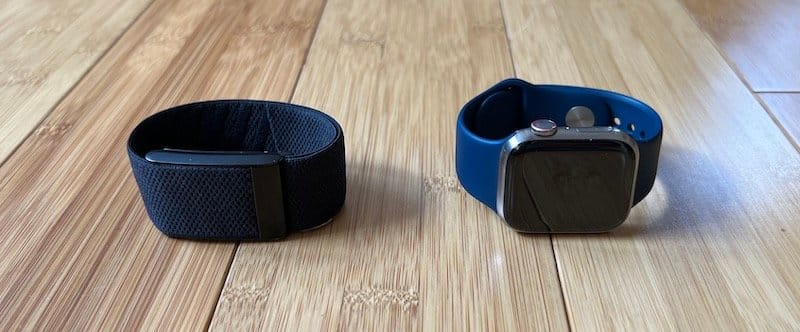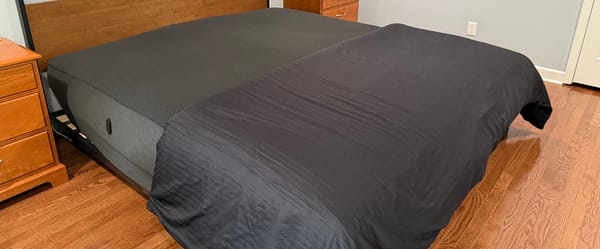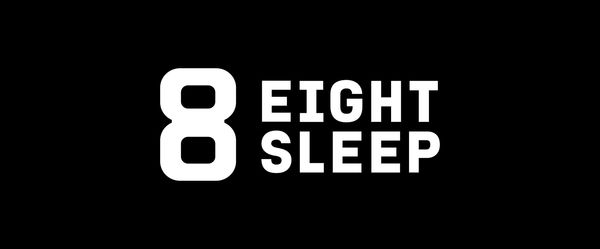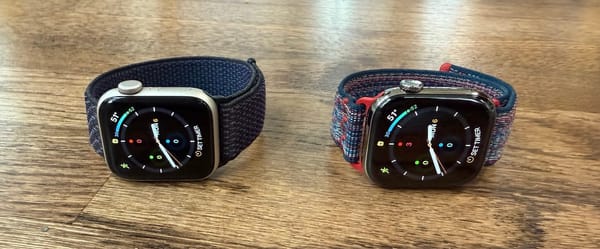Whoop vs. Apple Watch: Do You Need Motivation or Recovery?

I’ve been wearing an Apple Watch for more than six years, an I’ve had the Whoop 4.0 on my other wrist for the last two months. I like both fitness bands, but they aren’t trying to serve the same type of person.
Apple Watch is the ultimate exercise and motivation tool, while the Whoop 4.0 focuses on optimizing recovery by analyzing sleep, activity, and heart data.
I’ll compare both wearables by going over six different categories. Then, I’ll make a final recommendation and tell you which one I plan to keep.
Motivation
Apple Watch
Apple Watch uses three activity rings to monitor your activity. The Move Ring counts the number of active calories burned, which can be manually changed to cater to your needs. Apple Watch checks your rate continuously while in workout mode to calculate how many calories you’ve burned.
The Exercise Ring counts how many minutes you’ve exercised.
The Activity Rings along with awards for completing challenges gamify exercise. There’s no doubt you’ll be motivated to stay active with an Apple Watch on your wrist.
Before Apple Watch, I would exercise a couple of times per week, but now I religiously try to close my rings every day and it’s just part of my daily routine.
Whoop
Whoop uses a metric called “Strain” to measure how active you are, which is based on a few different heart rate metrics. Each day, Whoop provides an “Optimal Strain” number based on how recovered your body is.
While Apple Watch wants you to fill out your Activity Rings, Whoop encourages you to take things slower.
People who typically buy Whoop are already active, so Whoop assumes you don’t need the motivation. However, Whoop motivated me to take it easy on days where I was ready to break my Peloton personal record.
One area where Whoop has an advantage over Apple Watch is that it takes 52 samples of your heart rate per second 24/7 (even if you’re not active). Apple Watch only checks your heart every five minutes while inactive.
Exercise
Apple Watch
For exercise, Apple Watch has a bunch of advantages over Whoop.
First, let’s start with the screen.
The screen lets you easily start a workout with a couple of taps. And during a workout, heart rate, duration of exercise, and miles run (or biked) can be viewed with a quick look down. For running, knowing how far I’ve run is essential.
Apple Watch has a built-in GPS that tracks your route and miles without your iPhone being nearby.
To take things to the next level, just download an Apple Music playlist on your watch before a run, then you won’t need your phone at all. Running with just a watch and AirPods is a game-changer.
The final area where Apple Watch excels is the exercise dashboard that displays your recent trends and has a way to filter and view all of your past workouts.
Whoop
The Whoop Strap doesn’t have a display, which may be an advantage for those who don’t want the added distraction that a screen usually brings.
But I like having access to miles traveled during bike rides and runs or my heart rate during weight lifting on my wrist. There are plenty of workarounds, like keeping your phone open, but a screen on your wrist is convenient.
Due to Whoop’s lack of a GPS, for cardio activities, you need to bring your phone with you. You can log the run afterward because your heart rate is always tracked, but Whoop has no way to map where you went or know the miles traveled. To get your miles and route tracked, just start the workout from the Whoop app.
After a few workouts, Whoop uses your heart rate spikes and previous workout data to auto-detect and log your workouts. It works well for runs.
Accuracy issues:
Over two months, my average heart rate for each weight lifting session, compared to Apple Watch, was at least 20 BPM lower.
I reached out to Whoop and they thought my Whoop was losing skin contact. We played around with my Whoop’s placement, but that didn’t seem to help.
It’s not a hardware issue because heart rate recording works fine during cardio activities, like running and biking.
My best guess?
There’s a software or algorithmic issue that gets confused when there are heart rate spikes, rather than a smooth escalation. During weight lifting, my heart spikes up quickly to around 150 BPM, then I rest for 90 seconds until the next set.
Heart rate shouldn’t be super high during weight training, so the inaccuracy isn’t a deal-breaker, but it affects your strain scores, which will change how recovered Whoop thinks you are.
Maybe Whoop can’t measure accurately due to something unique with my body. Or maybe it’s a fluke. Although, The Quantified Scientist and Ali Spagnola on YouTube ran into the same issues as I did.
Interestingly, despite improved sensors, the 4.0 hasn’t improved a ton because I had the same heart rate issue when logging weight training with my Whoop 3.0.
The bottom line: Whoop’s accuracy should be spot on for cardio activities, but it can’t be trusted for activities with varying heart rates.
Recovery & Sleep
Apple Watch
Don’t get an Apple Watch if sleep tracking is your main priority.
Apple Watch’s sleep tracking is buried inside the Apple Health app. The sleep tracking shows if you hit your targeted amount of sleep, which is the most important metric, but it doesn’t display any of your sleep cycles or sleep quality.
Because of Apple Watch’s short battery runtime, sleep tracking might disturb your charging routine.
If you want to track sleep, I recommend supplementing Apple Watch with an affordable FitBit or Amazon Halo. There are free sleep tracking apps, like Sleep Cycle, that do a solid job too.
How about recovery?
Apple Watch assumes your body is ready to go 100% each day. It never customizes its recommendations based on a tough workout from the previous day.
The monthly challenges can be overly generic too.
For example, my April goal is to exercise for 1,800 minutes, which is 60 minutes per day. It’s doable, but if I complete it, my May goal will be 70 minutes per day. At some point, upping the bar by a small percentage, without any account for recovery, will become unsustainable. Once you close your Move Ring consistently, it’ll suggest an increase too.
Whoop
Whoop’s specialty is recovery. Whoop has an incredible interface that’s loaded with neatly organized data. It displays your strain, recovery, and sleep scores. There’s an online portal too.
Whoop sends a notification each night to let you know how much sleep you need and what time you should go to bed to achieve that.
Once you get in bed, sleep tracking is done automatically. Sleep is broken into three categories: light, REM, and deep sleep.
My favorite part?
Each morning, you answer a daily questionnaire about what you did the previous day. The questionnaire can be customized to include over 60 different variables. For example, did you consume a late meal, caffeine, alcohol, marijuana, have sex, along with tons of other factors.
After a month, under the monthly assessments section, you can see what impact certain variables had on your body. For example, I’ve learned that any amount of alcohol, even one beer, destroys my recovery for the next day.
Overall, Whoop’s recovery score seemed to jive with how I actually felt about 80% of the time.
But I have questions about its accuracy and approach. There were numerous days where Whoop rated my recovery as above 80%, but I felt tired or didn’t have enough strength. And there were days where I felt strong and Whoop said my body wasn’t ready to perform.
Let’s look at how Whoop calculates the recovery score to understand what may have gone wrong on some days.
Whoop uses heart rate variability, resting heart rate, respiratory rate, and amount of sleep to calculate your recovery score. According to Whoop, you’re recovered when your HRV is close to your personalized baseline HRV.
Basing recovery on HRV is backed by science, but Whoop’s way of calculating it might not be the best. For consistency, Whoop calculates your heart rate variability through out the night, but it weighs its calculation toward your final reading during your last deep sleep cycle. The problem? My Whoop does a poor job of knowing when I’m in deep sleep.
Healthy adults should get around 1-2 hours of deep sleep. I’m as healthy as anyone and feel well-rested on most days, but my average is just 47 minutes per night, according to Whoop.
For another reference point, I’ve used the Oura Ring for more than six months, and according to Oura, my deep sleep is twice the amount of Whoop. And Oura’s HRV has been more consistent because it takes an HRV measurement every 5 minutes while you sleep and creates an average.
I love the idea behind Whoop: optimize every input and output from your body to maximize performance and longevity. But if the data isn’t completely accurate, Apple’s more generalized approach makes more sense.
Battery
Apple Watch
Modern Apple Watch models are rated for 18 hours of battery life, but I averaged about 35 hours of runtime with two hour-long workouts and eight hours of sleep tracking with the SE and Series 7.
Either way, Apple Watch needs daily charging.
If you don’t plan to use your Apple Watch for sleep tracking, just charge it when you go to sleep.
When I track sleep, the easiest charging routine is to do it right after waking up. The short battery life shouldn’t be a huge issue if you stick to a routine, but it’s still a limitation and won’t be convenient for everyone.
Whoop
Whoop has an awesome battery approach.
The Whoop charger comes in two pieces: a cord and a backup battery. The battery runtime is listed for five days, and I got about 4.5 days in my testing.
After I workout, I put my Whoop on the charger while I shower and get dressed. This 10-15 minute charge is enough to top off the battery for the day.
Even easier, just slide the battery pack on top of your Whoop while wearing it. I don’t like carrying around the extra weight of the battery pack, but it’s perfect if you’re in a pinch and need juice. There’s no risk of accidentally leaving Whoop behind on the charger with this approach.
Because of the long battery and backup battery pack, no matter the charging method you choose, battery life is almost never a concern, which is a huge benefit compared to Apple Watch.
Design
Apple Watch
Apple Watch bands are easy to switch out and come in nine different styles (check out my comparison of all the bands).
I’ve found most of the all-purpose bands are comfortable, specifically the Sport Loop. The Sport Loop looks similar to Whoop’s default band, but it’s softer on the skin.
You can switch out from the sporty bands to something more formal, like the Leather Loop or the Stainless Steel Milanese Loop.
Apple Watch weighs more than Whoop, but there’s only a tiny circular part that hits the skin, which gives your wrist more freedom. I can always feel my Whoop, but rarely my Apple Watch.
Whoop
Whoop has lots of band choices. I can’t speak to the quality of all the bands because I’ve never tried them, but the quality of the default black band isn’t nearly as nice as the Apple Watch.
Three are two annoying aspects to Whoop’s design.
The extra slack doesn’t always stay under the band, so it sticks out.
Whoop isn’t as comfortable because the entire band needs contact with your skin.
Whoop’s more versatile than Apple Watch because it can be worn on your bicep rather than your wrist if you buy the optional band.
Price
Apple Watch
The Apple Watch Series 3 is $199, the Apple Watch SE is $279, and the Series 7 is $399. All of these watches perform similarly. My recommendation is to go with the Apple Watch SE for $279 because it’s the best value.
If you’re interested in buying an Apple Watch, check out my other comparison: Apple Watch SE vs. Series 8
Whoop
The Whoop 4.0 device is technically free, but there’s a $30/month subscription fee with a six-month minimum. So at a minimum it costs $180.
If you pay annually, the price drops to $25/month, which will cost you $300 upfront.
If you pay every 24 months, the price drops to $20/month, which will cost you $480 upfront.
Even if Whoop ($480) and Apple Watch SE ($279) were priced identically for two years of ownership, I’d choose Apple Watch.
Which is best for you?
Whoop struggled to get accurate heart rate readings during my weight training workouts. And because of imperfect sleep tracking, my recovery score was questionable about 10% of the time compared to how I felt physically.
You can’t rule out that there’s something unique about my body that causes inaccurate data with both of my testings of Whoop (3.0 for six months and 4.0 for two months). I’ll go forward as if there were no issues with the data.
Apple Watch

- Activity Tracking (A)
- Recovery (C-)
- Value (A)
Get Apple Watch if you want the perfect exercise tracker and motivation companion. It has a screen to start your workout and to check your status as you're exercising. The best part is you can leave your phone at home and still get access to accurate exercise tracking and your Apple Music. Apple Watch brings extra utility like pinging your phone to find it or using Apple Pay too.
Whoop Strap 3.0

- Activity Tracking (C+)
- Recovery (A-)
- Value (C)
Get Whoop if your livelihood relies on your body being in peak condition. For a regular person who’s just trying to make healthy decisions, an in-depth device like Whoop is worth wearing for a few months to learn how much sleep, exercise, and consumption are optimal for your body each day. Then, once you’re conscious of how your body operates, you can probably manage your body’s needs without the Whoop.
Which one am I keeping?
Before buying my Whoop, I planned to keep both devices because they serve different purposes, but Whoop’s day-to-day data wasn’t super accurate, and I’m not willing to give up wrist real estate to keep it around.
Even for someone who’s extremely health and fitness-focused, like I am, the Whoop has been overwhelming at times. In a way, it’s taking away my free will. I was exercising less intensely because Whoop said my body wasn’t ready, even if I felt fine. Or I’d skip the beer with dinner because I knew my HRV would be poor the next day.
Although, answering the daily questionnaire and seeing the long-term trends of how different inputs affect my sleep were interesting and helpful. But now that I know what I need, I don’t think it needs to be on my wrist.




